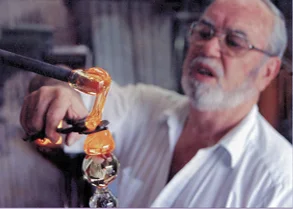The Hamon marble is one of the best marbles in the market. Yet, Robert delved into the marble world late in his career, and made many nice pieces during the mid- to late-nineties. His brother, Dick, suggested that he get into marble making because his considerable glass blowing skills would serve him well. Indeed, Bob made gorgeous marbles, all by hand, just the way he would craft paperweights, which was his first love.
The Hamon marble had to be good enough to maintain Robert's reputation as one of the most skilled artists in the state and country. Brother Dick was one of Bob's best friends and, together they imagined glass designs and worked out the technical details. Their collaboration continued until the twilight of Bob's career. Dick went to marble shows and sold Bob's handcrafted marbles, and provided an important link to the marble world. Bob, on the other hand, liked to stay at home in Scott Depot, West Virginia, where he could be near his studio, and work any time of the day or night. He took long walks in the woods, seeking inspiration, and found new ideas in his dreams. Making several walks to the studio, which adjoined his home, Bob kept an eye on the glass studio day and night.
Bob would have been a hit at the marble shows because of his gregarious, outgoing personality. He was one of the most interesting and compelling, even charismatic individuals I've ever known. And Bob's glass was as alluring as Bob himself.
What makes the Hamon marble exceptional? First, Bob made his own glass, using time-honored secret recipes. Okey B. Hamon, Bob's father, had a very nice crystal recipe, which Bob modified over the years, resulting in a spectacular crystal, built upon Bob's own chemistry. The Hamon marble shines partly due to the high quality of glass used to make it.
As a child, I used to marvel at the huge piles of chemicals used in making glass, and watching the men fill-in or put the raw batch in with shovels. The glowing furnaces were a thing of beauty to my mind, and the heat they generated just shimmered in the air, the sweat pouring from the glass worker's faces.
Second, Robert brought a broad and substantial craft to the task of marble making, which made his marbles better than average. Bob built and annealed his marbles properly, removing areas of stress in the glass, and his high level of craftsmanship, as a glass artist, provided the foundation for exceptionally designed and executed marbles. Bob was a consummate maker of free-form, hand-blown sculptures, figurines, paperweights, vases, candy dishes, flower vases and just about every other type of glass concoction.
On many occasions, I watched my uncle entertain large groups of people by making impromptu figurines. He'd ask someone in the audience what they wanted him to make and he'd make it, right then and there. And, it would look incredible. The "oohs and awes" erupted from stunned audience members as the pieces cooled and came to life.
Third, there were few imperfections, such as unwanted bubbles, in Bob's marbles. Uncompromising quality and technique ensured a beautiful marble, combined with crystal glass clear and bright, and of exceptional clarity. As time went by and Bob became more skilled in navigating the demands of handcrafted marbles, he put a great deal of effort into his artful color-combining, which I feel makes the Hamon marble stand out from the crowd.
In the end, Bob learned to enjoy making marbles, although I think he found them less challenging than paperweights or his large solid-glass art sculptures. It seemed that whenever Bob was making marbles, perhaps along with brothers Don and Dick, there were plenty of jokes and laughs (a few off-color) to go around. If you were an innocent bystander, you had to be ready to end up as the brunt of a joke, too. Everyone got into the action, and everyone had fun.
What good therapy it was. I'd spend hours watching my uncles toil in the heat of the family glass studio, and laugh like I was attending a George Carlan show -- Carlan was Bob's favorite comedian -- while having the opportunity to watch Bob mix colors and spin his tiny glass marvels out of globs of flaming-hot glass. Watching a handful of freshly made marbles slowly reveal their true colors, as the orange glow of the heat faded, was a joy I'll never forget. I can still feel the heat penetrate the pores of my skin and warm my soul.
Bob was not your average marble maker. And he only made marbles for a few years, but how special they were. And what memories they made. I treasure the Robert Hamon marbles that I own, and I like to pull them out and examine them in the shards of light from a sunny window, as all the old memories flood into consciousness. Memories of a most unusual glass master sweating before the glory hole, as he was heating-in, or gathering from the hot glass tank, dance in my mind, larger than life.
Fridays were the hardest days on which to gather because the glass level had been lowering all week, until the glass was so low that the glassblower had to reach further into the tank, exposing his hands to the blistering heat. I've seen my uncle handle hot pipes that no normal man could have handle with his bare hands, and not even flinch. He was a tough man with refined tastes, and skills that he spent a lifetime building. Sixty-two years is a long time to blow glass. And it's a daunting span of time, exposing the glassblower to many physical and mental hazards. But, by the end of his sojourn in the world of glass, Bob was at the peak of his powers.
And we are the benefactors, for we have the fruits of his labors to admire and cherish.
